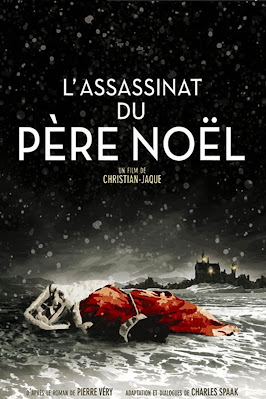You wouldn’t know it from the title, but Who Killed Santa Claus? is a lovely little Christmas fable whose artifice is less than perfect, but artful all the same.
Firstly, just as the French traditions of what they call Noël are only vaguely
paralleled by our grossly impure American traditions of Christmas, the title of
the Christian-Jaque film L’Assasinat du Père
Noël
isn’t quite what English-speaking filmgoers got when they watched Who Killed
Santa Claus? Père Noël (an old
artisan played by the great Harry Baur) goes house to house on Christmas Eve to
have a drink and lecture children about how well or badly they behaved during
the year. Children even stay awake to be in his presence, instead of pretending
to be asleep. But the village in the film is a poor one, whose families can
barely afford the smallest toy for their children.
Secondly, quite apart from its qualities as a film, Who Killed Santa Claus? is reputedly one of those “encoded” films made during the German Occupation of France (1940-1944) whose subtext has something to do, presumably, with who betrayed France in June 1940. Marcel Carné’s Les Visiteurs du Soir is another, but that film is marvelous without having to bother about any clandestine messages.
Shot in a snowbound
village in the French Alps, L’Assasinat du Père Noël places us among people effectively
cut off from a world beyond the mountain peaks where, in the abundant exterior
shots, even the use of filters that can turn day into night (a technique the
French call “la nuit Americain,”), it’s sometimes hard to tell them apart.
The cast includes
a few faces familiar to an avid fan of French cinema, like Robert Le Vigan, who
played the suicidal painter in Quai des brumes, Fernand Ledoux, who played the
cuckolded husband in Renoir’s La Bête humaine, and Bernard Blier appears late
in the film as a gendarme.
But the film
belongs to Harry Baur, who had become one of the finest and most beloved actors
in French cinema by the time he appeared here as the globe maker, Gaspard Cornusse, and he invests the role with an
imposing weight. Cornusse is a world traveler who tells everyone who cares to
listen stories of all the places, especially China, he has visited. His tales inspire
Roland de La Faille, the local Baron, to
leave the village and travel to the four corners of the earth searching for something
he can neither find nor define. On his return to the village, Roland blames old
Cornusse for encouraging him to become a wanderer, and of ruining himself in
his wanderings. Cornusse’s daughter, Catherine, seems to live in some kind of
trance, like la belle au bois dormant. When she learns that Roland has returned
to the village, she awakes and announces that she has always loved him since
she first saw him ride down the village Street on a white horse.
But a sinister
figure intrudes on the placid town on Christmas Eve when the church’s old
priest places a priceless relic of Saint Nicholas, a diamond, on a star above
the Nativity scene. The gem is stolen during the Christmas service when Léon Villard, the village schoolmaster (and intellectual ass) stages an explosive
demonstration outside the church (on behalf of atheism!). Witnesses say they
saw old Cornusse near the Nativity scene, in his full Santa disguise. But when
Santa is found dead in the snow, and is unmasked as a (dead) stranger, the
clues point at Cornusse himself.
Charles Spaak,
whose credits include the classics Le Grand Jeu, La Kermesse Heroique, and La
Grande Illusion, adapted the film’s script from the Pierre Very novel. Much of
the film’s length is taken up with the dropping of clues to solve the double
mystery, but they are – thankfully – inconsequential because so much is going
on in the film. But it all ends sweetly with Santa giving a secret gift to a
sick child as no one other than Dickens could have brought off successfully.
Christian-Jaque –
who later married Martine Carol, Lola Montes herself – proved, with his earlier
film Les Disparus de Saint-Agil, to be one of those filmmakers who know how to
direct children, and he does beautifully again here. Armand Thirard’s photography,
which included working in what must have been difficult conditions high in the
Alps where snow is piled three feet deep on rooftops and paths through the snow
are constantly having to be cleared, provides beautiful shadow effects on the snow.
Watching Cornusse in his Santa costume struggle from house to house – and drink
to drink – is entertaining in itself.
L’Assasinat du Père
Noël is an altogether surprising, but strange film. It was restored by Pathe in
2015 and its rediscovery is another droll chapter of the process of film
restoration that will perhaps never end. It originally premiered in Paris on October 16,
1941. It was the first film produced by the German-owned Continental Films.
Shortly thereafter, Harry Baur was accused by the collaborationist newspaper Je
suis partout of being a Jew. According to Roberto Chiesi
in his tribute to Baur, “[he] fended for himself and went to Germany to shoot a
film, but in May of 1942 he was arrested and tortured for four months by the
Gestapo. The experience reduced him to a shadow of his former self, and he died
on April 8, 1943.”(1)
Whatever coded messages are hidden in L’Assasinat
du Père Noël will have to wait for scholars
to decode. For now, it is well worth the wait to see at Christmas.
(1) The tribute is located here.

No comments:
Post a Comment